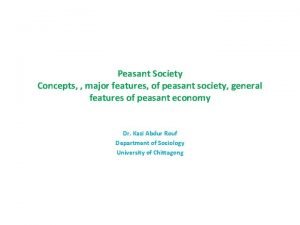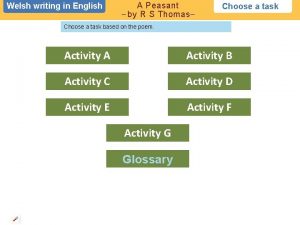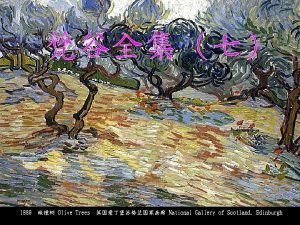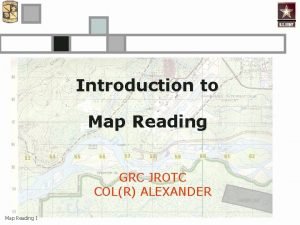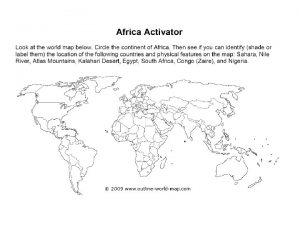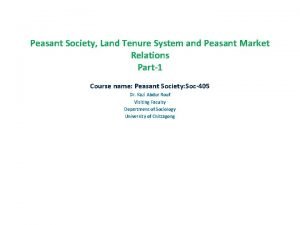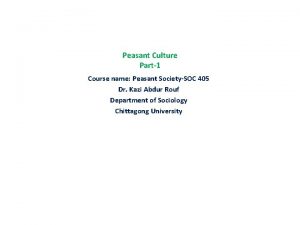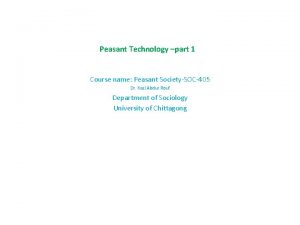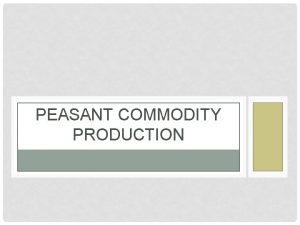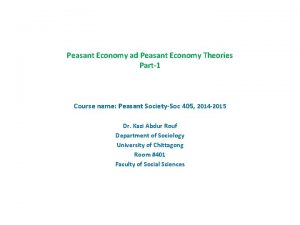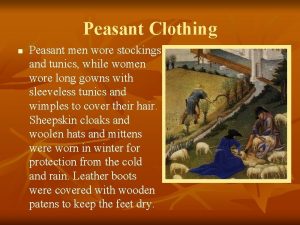Peasant Society Concepts major features of peasant society













- Slides: 13

Peasant Society Concepts, , major features, of peasant society, general features of peasant economy Dr. Kazi Abdur Rouf Department of Sociology University of Chittagong

Definitions, concepts of Peasant Society • Peasants (Krishoks) are attached and integrated with soil cultivations • They have plantation economy and customary agricultural economics activities in the villages • Krishoks of Bangladesh are small scale local producers • Peasants are rural natives • They have strong kinship, but simple equipments, relaying on substance produce • They are miserable marginal peasants in rural Bangladesh • Peasants sell and buy their cultivated products in cities, but the prices are determined by the market • Periodic festival gathering at different occasions in the villages, they have their specific rituals, values, believes, and practices

Concepts-Continue-2 • • Some scholars substituted peasant society as Folk society, folk culture Peasants together generate national economy Land lord peasants have strong ties among them , but marginal peasants are isolated. Peasant society is often described as intermediate-transitional Redfield says, “The peasant is a half-way house and a stable village structure-. This society is often described as static-unchanging Transitional meaning folk-urban continuum- cultural lag- peasant adjust them with the city commercial dynamics

Concepts Continue-3 • Their agricultural knowhow treated as traditional / backdated • They are not autonomous to communicate (primary relationships) with their communities • They are the producers of agricultural products, control and use their own land • Peasants have developed their own songs, music, sports and festival, beliefs, rituals, but now they are depending on peasant-city relationships • They automatically loss their power • However, still they maintain close contact with people in neighboring villages • Commercial farmers are profit oriented at the cost of Krishoks

Feudal Society • Land lords and land cultivators (peasants, serfs, Krshoks) • Feudal land tenure system: • Land lords (land owner, rural elites, rural power structure in the villages • Serfs (land cultivators) • Subsistence agricultural food producers • Self -sufficient village community in Bengal • Different agricultural groups/categories • Powerful land lords and powerless peasants- exploiters and sufferers • Peasants livelihoods and village traditional agricultural management system • Not segmented society-whole society in village • Turned to industrialization and capitalist society –accumulation and concentration of powers and resources

Absentee landlords development • Each society has two dimensions: Vertical and Horizontal • Horizontal peasants- equal status in the peasant society • Vertical-up class, powerful people influential people, absentee landlord • Pre-industrial society- developed urban centers, money is commonly used and developed market procedures and market efforts • Source of non-agricultural innovation and diversified products.

Peasants positions in the capitalist society • If agricultural production hampered, they suffered from starvation and miserable life, no food security for peasants from the state • Peasant are losing their own cultural forms and norms • Non-agricultural groups are dominant • Peasant are rural proletariat and became urban worker, relatively powerless • Peasant survive in the modern world because of cultural lag, dependent on modern elites • Change rural institutions-family, clan, serfs, community • Peasant leadership is normally weak-inefficient in meeting their traditional and domestic demand • Decaying peasant traditions

Peasant social structure • Two types of peasant social structure: Patron-client patterns and Fictive kinship • Patron-client pattern: villagers seek out more powerful people-city dwellers, wealthy owners and religious leaders with powers to aid • Fictive Peasant: The second common structural device –peasants fortify their positions in their communities and in their wider societies. • In the economic sphere peasant is also a subject to his larger social unit • Peasants rarely set the prices that they sell and buy. Prices are fixed by international forces/corporations • Elites drain off most of the economic surplus • Peasants hate and fear cities because city dwellers control over them

Village Aid Program • Now peasants are dependent on city for their non-agricultural products and needs • Increasing landless, marginal and small peasants are increasing • V-Aid program started in 1950 based on agricultural extension model to serve peasants • This program differentiated gender division of labor-male’s work (agricultural work) and women’s work (home economics) • Women are also involved in harvesting, gardening, poultry raising and livestock care apart from domestic work • Women were given training on smokeless chulas, proper health care, home sanitation or nutrition

Problems of the peasants in Bangladesh • • • Traditional agricultural practice treated primitive Income from agriculture are lesser than non-agricultural occupation No organizational outlets at the grass root level No agricultural training for mass people Agricultural development agents are outsiders of the village Initiated the social welfare approach-mother’s club in 1960 s and onward Peasant programs are controlled by outside organizations, Target groups are mainly women-sewing, weaving, handicraft making No peasant community centers Started Cooperative movement approach: IRDP, BRDP, Thana Training Development Center (TTDC) in 1960 s, 1970 s and continue but cooperative managers cheating general cooperative members

Peasant problems -continue • Cooperative members are cheated by cooperative managers • Women are relying on repaying loans, irregular supply of goods and services from the government • Agricultural credit for marginal farmers are few, but if credit is available , incurred high interest rate • Industries and housings are continuously occupying and destroying agricultural lands • Destroying village self-sufficient concept • Destroy the ecological balance in the village , nature and society • Diminishing village leadership and village informal Shalishi (non-formal Justice) System

Next Class • Peasant Economy theories • Peasant social sphere theories • Please read Bangladesh Krishok Samaj by Monirul Islam Khan- Third article of the book

• Comments/ Questions • Group Discussions • Wrap up • Nest Class- Thursday, November, 27, 2014 at 10: 00 am-12: 00 noon
 Features of peasant society
Features of peasant society Ts revolution ch 1
Ts revolution ch 1 Rs thomas a peasant
Rs thomas a peasant Tudor peasant clothes
Tudor peasant clothes Peasant woman binding sheaves
Peasant woman binding sheaves Utah ddw
Utah ddw Be like a russian peasant in a french patisserie
Be like a russian peasant in a french patisserie Peasant meal 1642
Peasant meal 1642 Major features of moon
Major features of moon Spur map reading
Spur map reading Identify terrain features on a map
Identify terrain features on a map Physical feature map of the united states
Physical feature map of the united states Physical features of canada map
Physical features of canada map Major physical features of africa
Major physical features of africa
